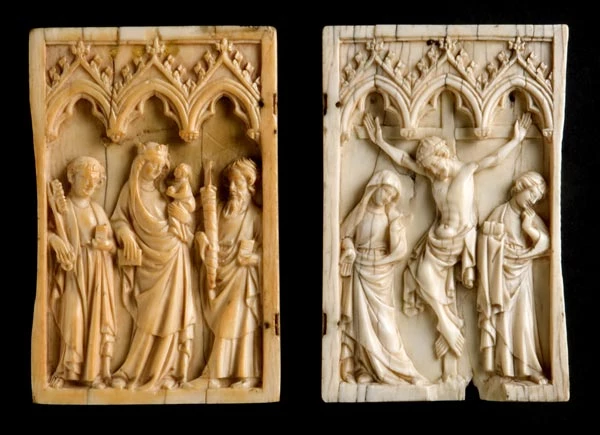The Llandaf Diptych
The diptych showing the resin replica of the Liverpool piece on display at National Museum Cardiff
Laser scanning the left leaf in Liverpool. (c) National Museums Liverpool
Married again: the two leaves of the Llandaf diptych. Left leaf (c) National Museums Liverpool
Medieval diptychs and triptychs were two- and three-panel images intended to aid devotion and meditation of Christ's life and suffering. A right hand ivory diptych panel from Llandaf housed in the collections at Amgueddfa Cymru has recently been reunited with its left hand panel for the first time in over a century.
Medieval ivories are known from secular sites in Wales, such as gaming pieces from castle sites and a small shield from Caerleon (Monmouthshire). A figurative ivory with devotional significance has been excavated from Dolforwyn Castle (Montgomeryshire), while a carved ivory diptych from Valle Crucis Abbey (Denbighshire) was reported in 1866.
However, as in England, many objects of private devotion in Wales were destroyed in the sixteenth and seventeenth centuries; many diptychs in museums are now incomplete, the partner panels becoming separated in antiquity.
Occasionally, missing elements are rediscovered and reunited.
The Llandaf diptych
For over 100 years, the right hand panel of an elephant ivory diptych from Landaff has been considered a rare survivor with a Welsh provenance.
Made in Paris about 1340/60, it depicts Christ on the Cross, flanked by the Virgin Mary on the left and St John the Evangelist as a young man on the right, holding a book and turned away from the cross. The figures are positioned beneath an architectural canopy composed of three Gothic trefoiled arches, each surmounted by a triangular gable with crockets and finials.
According to museum records, it was discovered by Mr Henry Bird of Cardiff during the demolition of 'the old well-house' at Llandaf in May 1836. After passing through several hands, it was purchased in 1901 by the Cardiff Museum (precursor of the National Museum of Wales) from the estate of John Storrie (curator 1878-93).
Research has revealed that the decorative details, dimensions, condition and hinge positions of the Llandaf piece corresponded very closely to a left-hand ivory panel now in the collections of National Museums Liverpool. This left hand panel shows the Virgin and Child flanked by Saints Peter (bearing keys) and Paul (with sword), providing a neat visual counterpoint to the Crucifixion scene on the right panel. The architectural canopies on each leaf are the same, while the style of execution of the figures and size of the borders also correspond.
When did the two become separated?
The Liverpool panel was acquired in 1953 from the estate of Mr Philip Nelson, who purchased it from a dealer in Bath in 1934. The right hand leaf was bought by John Storrie from a shop of Mr L. Roberts. Could both have been found at Llandaf in 1836, to end up in different hands, or were they separated at an earlier date?
Llandaf, whose focal point remains the cathedral rebuilt by Bishop Urban (1107–34) and his successors, abounded in wells. Two of the better known examples are St Teilo's holy well (Ffynnon Deilo), and the "Dairy Well" in the grounds of Llandaf Court, a house used as the Bishop's Palace from 1869 to 1940. The latter became, for a time, the resting place for a late tenth- or eleventh-century cross shaft and head, set into its end wall in 1870. The thirteenth-century fortified Bishop's Palace lies to the south-east of the cathedral: could this have been the location of the original diptych?
Today the Llandaf diptych panel is displayed with a laser-cut resin copy of its partner, commissioned from National Museums Liverpool (Conservation Technologies). The latest technology was used to create an accurate replica of the Liverpool piece. A great advantage of this replication method is that it involves no contact with the original artefact surface and, therefore, no risk to the object whatsoever.


